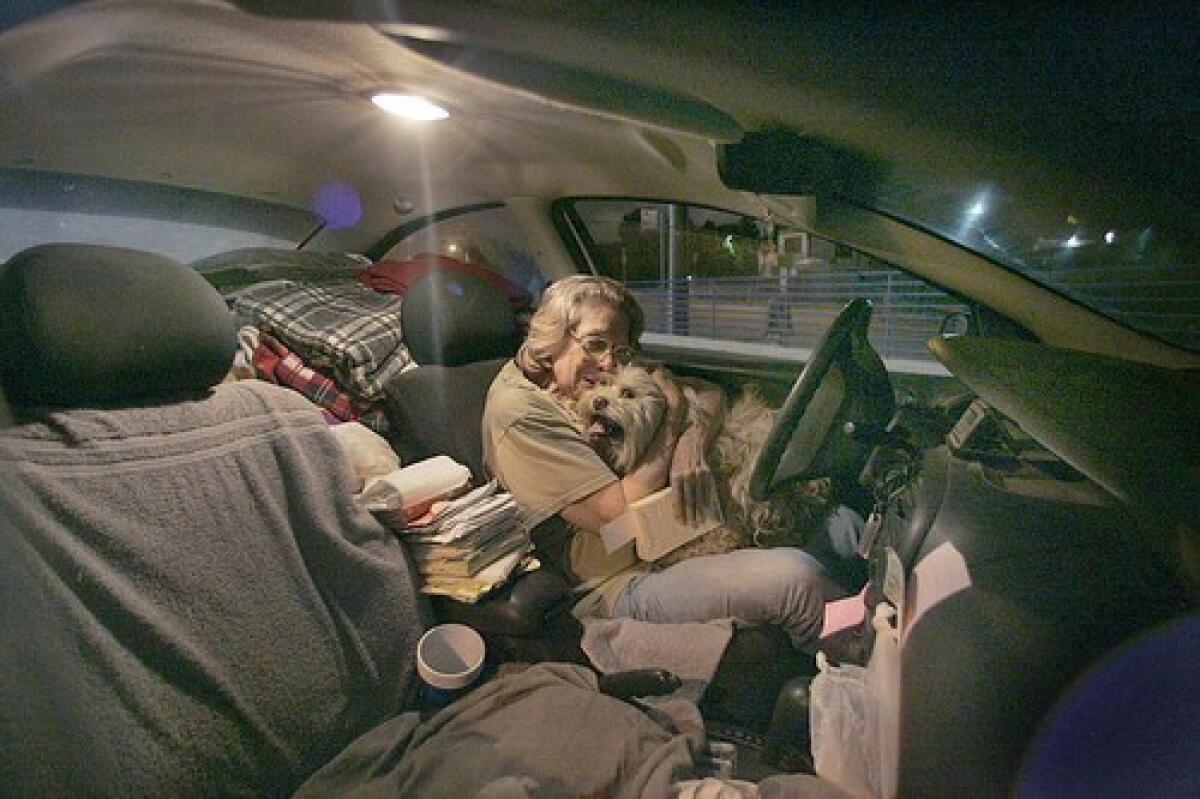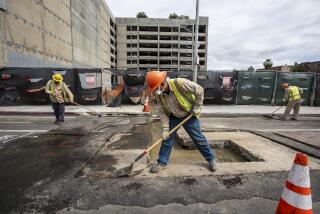Looking for an End to Her Skid

Six days a week at 7 in the morning, a gray Dodge Neon pulls up to a bluff overlooking the beach in Playa del Rey. The driver, a bespectacled 71-year-old woman named Lee Sevilla, is accompanied by her shaggy dog, Sandy. The two of them have lived in a car for more than eight years.
She never would have imagined it, said the silver-haired Sevilla. She was a wife and mother with a pretty normal life until a divorce and a couple of bad breaks put her on the street. It seemed like a temporary setback at the time, but the weeks became months and the months continue to drag on.
Sevilla sleeps in nearby El Segundo, where she pulls up to the same parking spot beside a public ball field each night and settles in. At dawn she uses the restroom at the nearby Chevron station, then buys a cup of coffee and drives to Playa. It boosts her spirits, she explained, to start each day with a million-dollar ocean view.
âItâs wonderful,â she said, looking out over Dockweiler State Beach, near the edge of LAX. âIf itâs clear I can see from Malibu to Palos Verdes, and sometimes Catalina. You can see the dolphins from up here too.â
The one day sheâs not there is Sunday. Thatâs when she pulls her church clothes off the hanger in the back seat of the Neon, goes to services at the Crystal Cathedral in Garden Grove, then splurges on a $45 room at a Motel 6 in Santa Ana. Donât tell anyone, but she sneaks in a hot plate to cook spaghetti, her one big meal of the week.
As for the Crystal Cathedral, âIâm not overly religious,â Sevilla said. âBut I do depend on Him more lately.â
Three days before I met her, in fact, she opened her journal one morning on the sea bluff, took pen in hand and addressed a note skyward.
âYou know, God, Iâm getting too old for this,â she wrote. âItâs getting harder and harder, and I canât seem to get out of this rut.â
When a reader in Playa del Rey suggested I track down Sevilla, I thought Iâd find yet another L.A. story of hard luck in the shadow of conspicuous riches.
But this one stands out: a great-grandmother who worked her whole life, avoids trips to the doctor because she canât afford the Medicare deductibles and has to sleep with a foot on the brake.
Sevilla is from Long Beach but moved to Chicago with her husband. When the marriage came apart in the late 1960s, she raised her three kids by working as an interior designer. She returned to California in 1989, following two of her children, but found it difficult to get decent pay for honest work. She wondered if her age -- mid-50s at the time -- was beginning to weigh against her.
A daughter took her in, but the apartment was cramped and Sevilla felt uncomfortable about imposing. When the daughter got married, Sevilla packed her bags, determined to make it on her own and confident that she would.
âItâs my responsibility to take care of myself,â she said, but that was easier said than done. She found part-time jobs, but with a developing heart condition, she couldnât be on her feet for more than a few hours at a time.
For a while, she ended up sacked out at her sonâs place in Irvine. But he had been in a terrible car accident, suffered brain damage and felt horribly depressed about the burden heâd become.
On Christmas Eve in 1998, Sevilla asked him to accompany her to church, but he wasnât feeling up to it. The next day, he went off by himself, put a gun to his head and took his life. He was 40.
Thatâs when Sevilla found herself living in the car, wounded, distraught, scared. She couldnât believe the depth of her fall, nor could she handle the dismissive stares from people who wondered what kind of loser ends up living in a beat-up Mercury Tracer with 300,000 miles on it.
Just hang in there, she told herself. Another week, maybe a month.
âI thought it was temporary. But it just keeps going.â
The situation is awful, said her daughter, who still lives in the same cramped apartment in El Segundo. But her mother wonât accept help, except for occasional loans, and is stubbornly determined to fix her own problems.
âI worry about her sleeping in that car,â her daughter said. âI think about her all the time.â
Six months ago, Sevilla answered an ad in the El Segundo Herald for a part-time receptionist. She showed up for her interview at the small, home-based company that refinishes bathroom countertops and furnishings, and got the job on the spot.
âIt pays $10 an hour, which is really pretty good,â she said. âAnd I love the people.â
Her employers donât know, by the way, that she has lived in the Neon for three years, having moved up from the Mercury. But the job is only 16 hours a week, and Sevilla clears less than $600 a month. Combined with her $480 Social Security check, itâs not enough to get her into an apartment.
âIf I could figure out how to make another $500 a month, I think Iâll be fine. But you just do the best you can. I think a lot of people donât realize how close they are to being like this. You lose one or two paychecks and it can happen quickly.â
Sevilla went to a shelter once but it wasnât for her, and she doesnât care to venture to skid row in downtown Los Angeles, where most of the homeless services are. Nor does she care to take a bed that could go to a woman with young children, even if some kind of transitional housing opened up. Her options are further limited because of Sandy, but there is no way she is ditching the Lhasa-terrier mix she picked up at the pound 10 years ago.
âI donât know if I would have gotten through this without her,â she said.
To look at Sevilla, youâd never guess she lives in a four-door economy car. Her shoulder-length hair has a nice wave and her clothes donât look like they were pulled out of the trunk. Over lunch at Cafe Milan in Playa del Rey, she wore a teal-colored El Segundo T-shirt and looked nearly a decade younger than 71.
âI do keep myself clean and neat,â she said. Itâs a matter of pride, she told me. She wants to project a look that says: âThis is not going to get the best of me.â
When she leaves the beach each morning, Sevilla goes back to the Chevron station and gives herself a quick sponge bath in the restroom before work. Itâs not the greatest setup, but when she gets to the Motel 6 on Sunday and steps into the shower, itâs like being at a spa.
âIâll tell you something: There are a lot of people out there living in their cars,â Sevilla said. Itâs no wonder, she adds, when you look at the price of a one-bedroom apartment, let alone a house.
âI just donât understand how we can go to Iraq and build up that country, but not be able to figure out how to get homeless people off the streets or build affordable housing.â
Still, Sevilla is sure that sheâs one break away from getting a place of her own. About 10 years ago, she answered a lifelong dream, got a student loan and took a few art classes at UCLA.
âI discovered Iâve got a gift,â she said, proudly showing me her pencil sketches of wildlife and domestic animals. âIf only I could figure out how to make something happen with it now. I seem to be in a rut there too.â
After she gets off work, Sevilla motors over to the El Segundo Public Library on Main Street to work on her drawings. Employees and patrons were so impressed, they began bringing in photos for her to sketch, and sheâs good enough to command $60 for a print. For an additional $20, sheâll make 12 postcards on handsome stock, using her laptop as a print shop.
âSheâs an amazing woman, and so talented,â said Roz Templin, a library assistant who, along with a colleague by the name of Kimberlee Carter, is trying to arrange an exhibit of Sevillaâs work at the library.
Templin said she can identify with Sevillaâs financial problems. She works two part-time jobs herself, helps cover the bill at her motherâs assisted-living home and wishes her pay went up as often as her rent.
âTo be honest,â Templin said, âIâm living paycheck to paycheck myself.â
After the library, Sevilla generally drives a few blocks to the area between the park and the gas station. The other day, she had a Post-it sticker on the console of her Neon.
âIce,â it said, reminding her to reload the Igloo she dips into at night to make a sandwich for dinner.
She eats at the park, then drives to the Rite-Aid parking lot and plugs in a 5-inch TV powered by the car battery. The reception is better at the drugstore, where she watches the local news, followed by the nightly news, and then scans the L.A. Times.
She said her heart filled when she read that my friend Nathaniel, who lived on the streets of downtown Los Angeles for years, had moved into an apartment.
âGood for him,â Sevilla said.
And thatâs the thing, she added. Every time she gets down, she thinks about all the people who are worse off. Sheâs not mentally ill, sheâs not hooked on drugs or alcohol. At least sheâs got a car and a few bucks.
It will get better, she tells herself. It will get better. And El Segundo isnât a bad place to be if youâre homeless. She feels safe, she told me, and looked after.
âI feel like a member of the community.â
She makes one last trip to the Chevron before turning in, then drives to her spot and rearranges the car, clearing enough space to recline. She says goodnight to Sandy and then says a prayer of thanks. Thanks for getting us through another day, she says, and then she drifts to sleep under a blanket of ocean air.
More to Read
Sign up for The Wild
Weâll help you find the best places to hike, bike and run, as well as the perfect silent spots for meditation and yoga.
You may occasionally receive promotional content from the Los Angeles Times.







